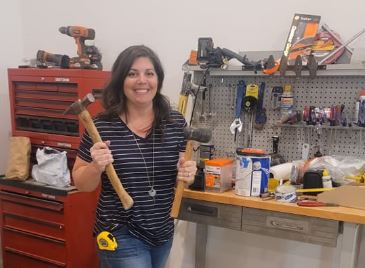
There’s something hypnotic about watching HGTV. All those farmhouse sinks and accent walls and reclaimed coffee tables give off the impression of effortlessness. In just 30 minutes, you’ve earned your degree in House Flipping. Armed with nothing but a sledgehammer and delusions of grandeur, there’s nothing stopping you from knocking your house to the ground and starting over. All you have to do is pick out super-expensive tile, relist the place, and voila! Money in the bank.
It’s that easy! (Not. Not at all.)
There’s no golden ticket to Fix and Flip Heaven, but if you do your research beforehand and put in the work, it can be an incredibly rewarding experience. As a realtor in Northwest Arkansas, I have found this to be true time and time again.
In case HGTV glazed over this part (*cough*), a “fix and flip” is defined as buying a property that needs work, fixing it up, and selling it for a profit. If you can buy a house at a reasonable price, make the necessary repairs and upgrades, and sell it for more than it costs you to fix, you can make some serious cash.
But be prepared; this is not for the faint of heart. Fixing and flipping can be risky, and I do not want to see you land in Fix and Flip Hell. If you’re thinking about making an investment like this, you can’t go into it blindly (especially while you’re carrying that sledgehammer).
So, then, where should you begin? Here are some things to consider before moving ahead:
Research, Research, Research
I can’t stress this enough. You must know the area you’re targeting. Know which neighborhoods in said area are in decline and which are up-and-coming. Look into the value of the properties and their expected condition. Then, close your laptop and actually walk around the area. Get a feel for it.
Remember, when you’re fixing up a house, you’re aiming to meet the expectations of the average buyer—not your own. What are people looking for in a modern house? What finishing touches will make your property stand out? It doesn’t matter if you don’t like them—you’re not going to live with them! What matters is that you’re inside the head of your ideal buyer. And you can’t get there without some in-depth research.
Once you know the market and have a purchasing plan (Do you have a lender? Are you paying cash? Have you been approved for a loan?), you can begin looking for the right property. You’ve done your research, so the best deals will immediately jump out at you (*wink*).
Figure Your Costs Correctly
Take a Santa Claus approach to your numbers. Check them once, check them twice, and if you’re feeling overconfident, check them again. Did you account for everything, including holding costs (the ones you encounter until you sell the property)? Every day you own this house, it is costing you money. Did you factor in closing costs for both purchasing and selling? Did you account for real estate commissions?
Of course, the biggest question here is whether you have the funds to make the necessary repairs and upgrades to your fixer-upper. You’ve crunched the numbers over and over again, but what happens when your contractor comes to you and says, “Hey, when we opened up this wall, we found [hairy, scary thing you didn’t want to hear],” or “When we pulled up the floor, we found [any number of gross things that nobody wants to deal with, least of all you].” Can you hear them, or are you blinded by the sight of dollar signs as they flush down the drain?
Have a contingency plan, and make it numerical to the tune of way more than I’ll need. One bad project can sink you. Add 15-25% to your expected costs.
Have a Clear Timeline
Sure, this project is bound to take a bit longer than you’re expecting, but it will take even longer if you’re planning to DIY it with your brand-new House Flipping degree. Remember, your holding costs are adding up every day.
Take into consideration your repairs and upgrades, marketing time, and the closing process. Hope for the best, but plan for the worst, just to be safe.
Get Your A-Team Together
This is your team of professionals who will help you make wise decisions and keep you out of the fires of Fix and Flip Hell. Hiring a quality contractor whom you can rely on is an excellent first move. You need to be able to trust them to be upfront about issues and honest about the costs involved.
You’re also going to want a realtor who is experienced in this facet of the industry to help guide you through repairs and upgrades. Great realtors know what it takes to sell a house and will stop you from installing laminate countertops in a neighborhood that demands granite (just saying).
Other professionals you should consider include a CPA, an attorney, and a lender. Unless you’re well-versed in tax law, owning rental properties, and financing, you’re going to want people in your corner who can help you make wise business decisions.
List Your Property
You’ve knocked down walls, installed granite countertops, and picked out your pretty tile. Somehow, against all the odds and despite a few setbacks, your fixer-upper is ready to flip. So… now what?
In short, it’s time to lean on your realtor (the one from your A-Team). They will make sure you’re in compliance with local disclosure laws, will help you negotiate with potential buyers, and can even market your revamped property while you move on to your next project.
Biting off more than you can chew makes for excellent TV drama, but IRL, it can land you in Fix and Flip Hell. More often than not, when an investor gets into trouble, it’s because they didn’t budget properly, leading to unfinished projects or profit losses. Even seasoned investors lose sometimes—it’s part of the game.
Rather than jumping in with your HGTV-colored glasses on, make sure you assess a potential fixer-upper with both eyes open. Budget for unknowns. Plan for setbacks. And most importantly, build a team you can trust. Fix and Flip Heaven is a lovely place, but it’s a heck of a lot more fun with friends.
